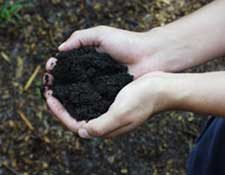 Humus is the upper layer of the soil that is composed of a set of decomposing organic matter, such as fungi and bacteria..
Humus is the upper layer of the soil that is composed of a set of decomposing organic matter, such as fungi and bacteria..
This layer is especially characterized by its blackish color as a consequence of the large amount of carbon it contains. It is more feasible to find in the highest parts of the soils that have organic activity.
The degree of decomposition of the organic elements that make up humus is such that they become stable, not decomposing any more and do not undergo considerable transformations.
There are two types of humus, the old humus and the young humus.
The old, as a consequence of the long time that has elapsed, presents a color between purple and reddish, some of its characteristics are: humins and humic acids. This type of humus only physically influences soils, retaining water and preventing erosion. And the young humus is the one that has just been formed, therefore, it is that it has a lower degree of polymerization and is composed of humic and fulvic acids.
Among the important contributions that humus presents are the following: it makes it easier to till the land, prevents the formation of crusts or compaction, helps water retention, increases soil porosity, regulates plant nutrition, improves the assimilation of mineral fertilizers, produces carbon dioxide, contributes useful microorganisms to the soil and improves the resistance of the plants.
Pesticides, fertilizers and biocides contribute in some way to the degradation and elimination of humus.
For example, tillage kills humus by burying it.
So, taking these issues into account, some cultivation methods are currently being developed that do not destroy humus, such as the organic farming, direct seeding, among others.









